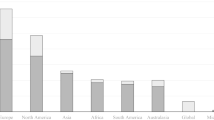Summary
Efforst to increase the rate of artificial recharge through basins often necessitates scrapping and ditching before and during operations. Such operations can result in more or less drastic changes in vegetation (depending on what was there before), characterized by diminisched numbers of species and lowered diversity. Two examples, one from Texas and one from the Netherlands are presented showing how similar treatments cause similar changes in two completely difference plant communities.
Similar content being viewed by others
References
Braun-Blanquet, J. 1951, Pflanzensoziologie. [Plant sociology]. 2nd ed. Springer Verlag, Vienna, 631 pp.
Cohen, J.E. 1966. A model of simple competition. Harvard Univ. Press, Cambridge, Mass., 138 pp.
Conover, W.J. 1971. Practical nonparametric statistics. John Wiley and Sons, New York. p. 293–316.
Correll, D.S. & M.C., Johnston. 1970. Manual of the vascular plants of Texas. Texas Research Foundation, Renner, Tex., 1881 pp.
Daubenmire, R. 1968. Plant communities. Harper and Row Publishers, New York, 300 pp.
Heukels, H. & S.J.van, Ooststroom. 1970. Flora van Nederland. J.B. Wolters, Groningen, 860 pp.
Leeuwen, C.G.van 1966. A relation theoretical approach to pattern and process in vegetation. Wentia 15: 25–46.
Londo, G. 1966. De huidige flora van het infiltratiegebied bij Zandvoort in vergelijking met ander natte duinvalleien in heden en verleden. [The present-day flora of the recharge area near Zandvoort compared with other moist dune slacks of the present and the past]. De Levende Natuur 69: 145–151.
Londo, G. 1975. Infiltreren is nivelleren. [Recharging causes leveling down]. De Levende Natuur 78: 74–79.
Maarel, E.van der. 1971. Plant species diversity in relation to management. In: A.S., Watt & E., Duffey (eds.). The scientific anagement of plant and animal communities for conservation, 45–63, Blackwell, Oxford.
Maarel, E.van der. 1976. On the establishment of plant community boundaries. Ber. Dt. Bot. Ges. 89: 415–443.
McIntosh, R.P. 1967. An index of diversity. Ecology 48: 392–404.
Pielou, E.C. 1969. An introduction to mathematical ecology. John Wiley and Sons, New York, 286 pp.
Pielou, E.C. 1975. Ecological diversity. John Wiley and Sons, New York, 165 pp.
Weaver, J.E. & F.E., Clements. 1938. Plant ecology. McGraw-Hill Book Co., New York, 601 pp.
Westhoff, V. & E.van der, Maarel. 1973. The Braun-Blanquet approach. In: R.H., Whittaker (ed), Handbook of vegetation science, part V: Ordination and classification of communities 737 pp., p. 617–726. Junk, The Hague.
Author information
Authors and Affiliations
Additional information
Nomenclature follows Correll & Johnston (1970) for American, Heukels & van Ooststroom (1970) for Dutch species.
I gratefully acknowledge the help of Dr. D. K. Northington, Assistant Professor of Botany and Dr. H. A. Wright, Professor of Range Management, both of Texas Tech University, for their verification of my plant identifications. I also thank Dr. E. van der Maarel for valuable advice on the construction of the manuscript.
Rights and permissions
About this article
Cite this article
van Hylckama, T.E.A. Changes in vegetation diversity caused by artificial recharge. Vegetatio 39, 53–57 (1979). https://doi.org/10.1007/BF00055328
Accepted:
Published:
Issue Date:
DOI: https://doi.org/10.1007/BF00055328




